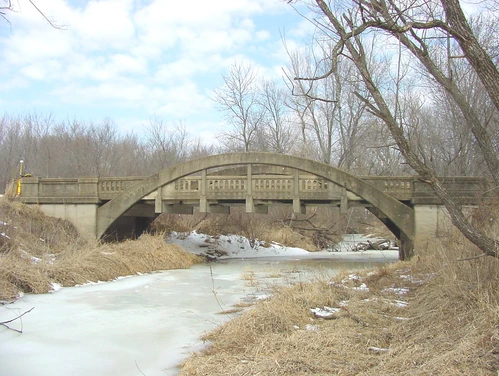- Year constructed: 1917
- Bridge type: Concrete Marsh Arch
- National Register of Historic Places status: Listed
- Length: 53 feet
- Width: 18 feet
- Spans: 1
- FHWA: 076930
- Jurisdiction: Boone County
- Location: 320th Street over Beaver Creek, 3.5 miles northeast of Madrid, Section 27, T82N-R25W (Garden Township)
Details
Consisting of a short-span fixed Marsh arch on concrete abutments and wingwalls, Big Creek Bridge II carries a gravel-surfaced county road over Big Creek in Garden Township, northeast of Madrid. This structure was designed in February 1917 by James Marsh, the Des Moines based civil engineer who designed and patented the rainbow arch configuration. A contract to build the Big Creek Bridge was awarded in April 1917 to the N.E. Marsh & Son Construction Company of Des Moines, Iowa, for $3170. N.E. Marsh, James Marsh's brother, completed the structure later that year. It has functioned in place since that time, in unaltered condition.
This small-scale arch marks a noteworthy innovation in bridge design, an achievement engineered and patented by James Marsh in 1912. Marsh's design represented the hybridization of continuous concrete and segmental steel-arch designs, a radical departure from standard engineering practice. Concrete can withstand a nominal amount of tension. For this reason, most previous concrete arches--both reinforced and mass arches in filled and open spandrel configurations--were built with the arch below the deck, where the downward force of the deck could be carried in compression by the arch ribs and spandrel wall or columns. Marsh's suspended arch reversed this.
His arches, of course, act in compression; but the hangers and floor beams carry the deck in tension. Furthermore, the novel treatment of the deck over sliding steel plates on the floor beams and the use of pin-connected, articulated steel hangers for the end panel points were devices more suited to steel construction than concrete. To make the concrete thus act against its nature, Marsh inserted large amounts of structural steel. His bridges may look like concrete spans, but the arch ribs and hangers carry such heavy and complicated reinforcing that they are, in reality, steel structures encased in concrete. Marsh designed his bridges with either tied (with the arches attached to the abutments at the floor beam level) or fixed (arches extending below the floor beams to the abutments) configurations. Aside from this, all of his rainbow arches were similar, varying only in span length, arch rise and number of hangers.
Marsh's invention did not foretell a new direction in reinforced concrete design. The industry would later turn to other, simpler slab and beam configurations as it developed more sophisticated reinforcing techniques in the 1930s and 1940s. The rainbow arch did, however, denote one of the more interesting early experiments in concrete engineering and represented the proliferation of concrete for road and bridge construction. It is not known how many Marsh arches were built in Iowa in the 1910s and 1920s: judging from county records perhaps not more than one hundred. The large amount of reinforcing steel sheathed within a relatively thin skin of concrete has made them particularly vulnerable to rusting and spalling. As a result, only a few are known to remain. The Big Creek Bridge II is distinguished as a well-preserved example of an indigenous structural type.
Adapted from Fraser 1992
Areas Served
- Boone
